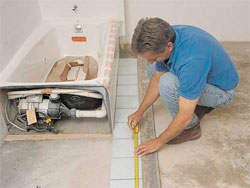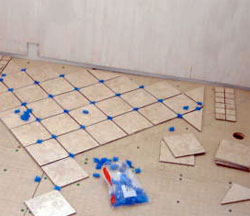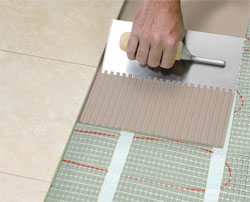Installing tile or stone in your home or office is a great way to accentuate natural beauty.
Before taking a dive right into this project, there are a few essential things you must know.
By reading these easy steps, your tile installing experience will be much less intimidating.
Preparation - Measuring Tile Area
 I. Measure the length and width of the area you wish to install tile on. Multiply these lengths together in order to find the square footage of the space. I. Measure the length and width of the area you wish to install tile on. Multiply these lengths together in order to find the square footage of the space.
II. Next, decide what size tile you would like to use in this space. By doing so, you can determine how much tile you will need. Also, keep in mind that as a beginner, purchasing extra tiles is a good idea. This accounts for improperly cut or scored tiles and also for breakage.
III. Once tile are purchased, prepare your base floor by removing all baseboards along the floor. Also, by cleaning all oils and with a safe chemical cleaner adhesives to better stick to the base.
IV. Be sure that your floor is level. If it is not level, tiles may crack after application and ruin the appearance. In many cases, you may need to use floor leveling compound to float out any divots or holes. If you find that the floor is not suitable, it is possible to cover it with plywood or un-tempered hardwood. When laying a new floor, nail every 4" along the edge and 4" apart in all directions. Also, be sure that four corners are not touching. Stagger the wood.
Pre-layout - A Dry Run
 I. Find the center point of your room. Use a chalk line to form a straight line horizontally and vertically in the room. Be sure that this is accurate. Measure twice, cut once. I. Find the center point of your room. Use a chalk line to form a straight line horizontally and vertically in the room. Be sure that this is accurate. Measure twice, cut once.
II. Next you should rehearse the layout of your tile without adhesive (dry run). Lay tile alone the line of chalk with spacers to see how they fit in the space. You can purchase these spacers at any hardware store. If there are obstacles such as bath pipes, you may need to cut a hole in the tile. For this, use a diamond hole-saw.
III. If the tile next to the wall needs to be cut in a much too fine of a line, it may be necessary to shift over one of the chalked lines so that cutting or scoring the tile piece is possible.
IV. Cut all tiles and make sure they all fit properly. Now your are ready for the real thing.
Installing Your Tile
I. Begin working in one of the quadrants of the room divided by the chalk. Start spreading the adhesive with a notched trowel from the center point. Spread evenly and use a raking motion so that grooves are not too deep or too shallow.
II. Set the first tile in the adhesive. Place it down and press firmly. Set your tile placer, as you did in the dry run and continue adding tiles. Use a spacer between each tile but be sure to remove them once the quadrant is done, so that it doesn't dry in the adhesive.
III. Mix the grout according to the directions on the bag. Apply at a 45 degree with a rubber float to work into the spaces between tiles. Take your time with this, or tile may shift and become uneven. Caulk may be used in joints of a wall or floor interfaces. Use a sponge with warm water to wipe grout off the tops of tiles as you go before it dries. Let caulk and grout dry for at least a week.
IV. Go over with a sponge one last time to ensure the tiles are free of residue. Then you may want to use a silicone sealant to finish the job.
Congratulations! You have installed tile.
| 


 I.
I. I.
I.